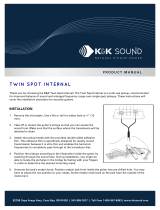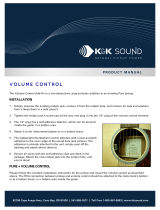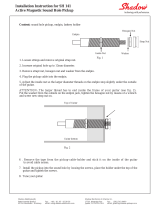Page is loading ...

92798 Cape Arago Hwy, Coos Bay, OR 97420 | 541-888-3517 | Toll Free 1-800-867-6863 | www.kksound.com
PRODUCT MANUAL
DEFINITY SYSTEM
GENERAL PICKUP INFORMATION
The Definity pickup is a hybrid of a compression
pickup and a soundboard transducer. Its super-thin
and flexible design allows for a variety of
applications especially on instruments with floating
bridges.
The Definity System is paired with the Definity
Preamp, which is optimized for the Definity pickup
and a very important part of the system. The Definity
Preamp features a phase switch, which is particularly
important for this pickup. Please see p. 3 for more
information on the phase switch.
We found the Definity System performs best when
the pickup is installed so that part of it is under
pressure by the floating bridge and part of it is “free
floating” to pick up vibrations like a sound board
pickup.
It is not necessary for the Definity pickup to cover the
entire area of a bridge or bridge foot. As a general
rule, you want to aim for a placement that allows
approximately half of the pickup under a bridge
(compression) and the other half free on the
soundboard. There are some exceptions for
instruments with narrow bridges, like banjos. (More
detailed information on this on p. 4.) But it is a good
strategy for Archtop or Maccaferri/Selmer guitars
and many other floating bridge instruments.
This manual will describe installation techniques and
locations that we have tested to deliver the best
results for a variety of popular floating bridge
instruments.
GENERAL INSTALLATION PROCEDURE
1. Mark the position of the bridge on the
soundboard with tape. Make sure the tape
will not interfere with the position of the
Definity pickup. Then loosen the strings and
move the bridge out of the way to allow
mounting the pickup.
2. Install the Definity pickup so that the bridge
stands on its front portion and the back half
(where the cable exits) sticks on the
soundboard, similar to how it is shown on
one of the photos below.
3. Remove the red release foil on the bottom of
the pickup and stick the transducer in place.
4. Move the bridge back into position and
secure the gray cable of the pickup with tape
so it does not cause noise.

2
92798 Cape Arago Hwy, Coos Bay, OR 97420 | 541-888-3517 | Toll Free 1-800-867-6863 | www.kksound.com
5. The jack can be mounted at a convenient spot
near the endpin of the instrument.
6. Coil up extra cable and secure it, e.g. with
clear tape.
OUTPUT JACK
The Definity pickup comes with a Switchcraft stereo
endpin jack wired in mono. It has a self-adhesive
removable clip attached to it. This jack also allows
for internal mount when the clip is removed. If go
this route, it may require you to temporarily unsolder
the pickup during installation. Please consult a
skilled technician if you choose this option.
Too remove the clip please use a slot screwdriver to
open the snap tab (see photo). Then remove the
black electrical tape that is wound around the jack.
This tape only builds up the diameter of the jack to
match the clip.
INTERNAL JACK INSTALLATION
1. For internal mount only, skip this section if
you are using the clip.
2. Drill or widen the endpin hole to 1/2" using
protective tape to cover the area around the
hole. This helps to prevent chips and
scratches.
3. Unscrew the endpin jack's strap mount knob.
4. Take off the nut and washer.
5. Find out the thickness of your end block and
set the nut on the cap accordingly (see
picture below). Once in place, screw the cap
in as far as it goes.
6. Insert the jack from the inside into the endpin
hole. Tip: a chopstick or something similar
helps to get a hold of the jack and pull it
through the hole.
7. Attach outside washer and nut and tighten.
Use a small Allen wrench or similar in the
small front holes of the jack to hold on while
tightening the nut. Attach the end knob and
tighten by hand.
Important: Make sure that the strap knob screws in
ALL THE WAY over the outer threaded part of the
jack, so that a tiny portion of the thread is exposed
when the strap-knob is tightened. If you don’t do this,
you might experience insufficient signal transmission
and sound cutting in and out.
THE DEFINITY PREAMP
Open the lid of the box (it just pulls off – it snaps back
on) to get access to the battery compartment and to
the adjustment options inside the preamp.
Install a 9-volt battery in the battery compartment.
There are midrange and treble trim-potentiometers
(trim-pots) that can be adjusted with a small
screwdriver. When the little white arrow in the center
of the trimmer is in the 12 o’ clock position, the
setting is flat with no cut or boost. Turning the pots
counterclockwise cuts frequencies, and turning
clockwise boosts frequencies. Mids are centered at
1250Hz (X-wide-band Q) and treble are at 8000Hz
(high shelf).
On the battery side of the circuit board is a phase
(toggle) switch with a small white tab. It has a big
effect on feedback control and on overall tone. There
is a detailed description of the effect on the phase
setting below. Move the white tab left or right (2
positions) and listen. There will be one setting that
sounds better with less feedback.

3
92798 Cape Arago Hwy, Coos Bay, OR 97420 | 541-888-3517 | Toll Free 1-800-867-6863 | www.kksound.com
CONNECTION TO AMPLIFIER
Use a regular guitar cable (not supplied) to connect
the output-jack of the pickup with the input of the
preamp. Connect the output of the preamp to an
amplifier with a regular mono guitar cord. Please
note that a stereo cable will NOT switch on the
preamp.
USING THE PHASE SWITCH
The Definity Preamp has a miniature phase switch
mounted on the battery side of the circuit board. It is
a sliding switch (a small white tab) that you can slide
to the left and right with your finger or with a small
screwdriver. There are only two settings.
The Pure XLR Preamp has a push-release phase
switch on the back.
Phase switches are usually marketed as a feedback
controlling device, but they accomplish more than
just that. A phase switch inverts the amplified sound
wave so that it does not interfere with the original,
un-amplified sound coming from your instrument.
Every acoustic instrument projects sound waves into
the air at a certain phase when it is played
unplugged. For optimal sound amplification, the
phase that is projected from the amplified speaker
source needs to be "in phase" with the acoustic
instrument's own acoustically generated sound
waves.
The problem is that amplification systems, effect
units, or any electronic audio device may or may not
invert the phase of the incoming signal. The
manufacturers do not specify. An out-of-phase
problem is indicated by early feedback and
somewhat tinny, unbalanced sound. This may be
tolerable in some tone ranges and quite noticeable
in others, even resulting in sound cancellations on
some notes.
By toggling the phase switch back and forth on the
Definity Preamp or pushing/releasing it on the Pure
XLR Preamp, you will notice fuller, warmer, and
nicely balanced tone with less feedback in one
setting. This is the correct phase switch setting. Keep
in mind that it may be different with different
amplification systems.
DEFINITY PRO WITH PURE XLR PREAMP
The Pure XLR Preamp operates on 12–48 volt
Phantom Power or 9-volt battery. The LED light on
the front-panel indicates if phantom power is present.
In order to save battery life it will not light when the
unit is running on battery power.
With phantom power, the battery will not be drained
as long as the phantom power provides more than
10 volt.
FRONT:
BACK:
CHANGING THE BATTERY
To insert and change the battery, open the 2 screws
on the sides of the unit, remove the lid, connect a
new 9-volt battery to the battery clip and place it in
the marked compartment.
The unit is delivered without a battery.
UNPLUG THE INPUT CABLE IN ORDER TO SWITCH
OFF THE BATTERY!
ADJUSTABLE GAIN CONTROL
Gain and volume both have an effect on the output
volume of the preamp, but they accomplish different
tasks.
The gain (also called input gain or sensitivity control)
is located at the INPUT of the circuit. It sets the
amount of pre-amplification before the signal enters
the EQ section, DI etc. The volume control is located
at the OUTPUT (the very end of the circuit) and
simply allows you to adjust the volume.

4
92798 Cape Arago Hwy, Coos Bay, OR 97420 | 541-888-3517 | Toll Free 1-800-867-6863 | www.kksound.com
It is very important to properly set the gain control to
fit the instrument you are using. An instrument with a
high output signal will require a lot less gain than
one with a weaker output. To set the gain correctly,
you have to connect your instrument to the Pure XLR
Preamp and to your amplification system.
Start with the gain at low (counterclockwise/left)
setting. The volume control on the Pure XLR Preamp
has to be set to fully clockwise/right and the EQ
should be about centered at this point. Adjust the
volume at the amp until you hear a fairly low volume
signal.
Now, play your instrument in your loudest dynamic
range (play it hard) and slowly turn the gain up until
distortion just begins to occur. Now back the gain off
a little bit until the signal is clear again. This is the
correct gain setting for this instrument.
Please keep in mind that excessive EQ boost applied
after the initial gain setting procedure may introduce
distortion, in this case you have to reduce the gain a
little bit.
OUTPUTS
The active DI XLR output and the line output can be
used simultaneously. This way, the 1/4" line out can
be used as a monitor out or for connecting to a tuner
while the unit is connected to the PA via the XLR out.
You can, of course, use each output individually.
EQ AND OTHER SPECIFICATIONS
The Pure XLR Preamp features strong +/-20 db bass,
mid, and treble controls. The special super-wide-
band midrange filter is absolutely great in
combination with the Pure pickups. The bass control
is set to roll of at 100Hz, the midrange at 1.5kHz with
extra large bandwidth and the treble are set at
10kHz. Input impedance is 1 meg. Output impedance
on balanced XLR and 1/4" line out is 100 Ohm.
Frequency response is 30 –30000 Hz.
REMOVING THE PICKUP
Carefully lift off the solid part of the pickup (the end
by the cable). Do NOT pull on the cable itself!
Once this part is loose you can use it to hold onto
and CAREFULLY pull the foil part off the instrument.
Try to avoid pulling the pickup at an extreme angle
and go slowly. Once you have enough of the foil part
off you can carefully hold on to the foil to loosen the
rest of the pickup.
If the old adhesive is still in one piece on the pickup,
you might successfully re-apply the pickup with it.
If the adhesive is spotty or does not stick anymore,
you can rub it off with your thumb. DO NOT USE
SOLVENTS ON ANY KIND as this may damage the
pickup. We include double-sided adhesive tape that
allows for a couple of new installations.
INSTALLATION NOTES: ARCHTOP GUITAR
Here we mount the pickup under the bass side of the
bridge. You can orient the pickup either with the
cable coming out towards the f hole or towards the
tailpiece. Both methods will yield nearly identical
tone. It depends on how you want to route the cable.
You can also lead the cable into the bass side f hole
and mount the jack internally if desired.
INSTALLATION NOTES: MACCAFERRI
GUITAR
Here we chose the treble side of the bridge.
Maccaferri bridges are supposed to have hollow feet.
On the guitar shown in the photo, we removed some
material at one side of the bridge arch to allow the
end piece of the pickup to sit inside the arch.
If you do not wish to modify your bridge, you can
orient the pickup with the cable towards the tailpiece.
Please note that due to the hollow bridge feet, the
pickup will be under compression at its outer
perimeter only. The inner part of the transducers will
act like a soundboard transducer.
We also shimmed the other side/foot of the bridge
with a piece of thin cardstock (we used a business
card that had the same height as the transducer). We
found that this was necessary for the bridge to sit

5
92798 Cape Arago Hwy, Coos Bay, OR 97420 | 541-888-3517 | Toll Free 1-800-867-6863 | www.kksound.com
perfectly flat on the soundboard and to avoid minor
sound balance problems. This phenomenon must be
specific to the hollow bridge feet as we did not
encounter this problem in bridges with sold feet.
INSTALLATION NOTES: BANJO
Here we simply stick the pickup under the center
foot. The bridge is standing on the very tip of the
pickup only. Make sure to secure the cable well! The
banjo head is very resonant and will cause buzzing if
the cable is not secured perfectly.
SEMI ACOUSTIC ELECTRIC GUITARS WITH
TUNE-O-MATIC BRIDGES (ES335 TYPE)
Even though it’s impossible to achieve a true
acoustic tone with this type of guitar (since there is a
solid wood block inside the center of the guitar
body), we believe that the Definity System is as
close as you can get. In our testing, we’ve found it
resembles an acoustic quality more closely than any
other acoustic pickup. We think that it sounds
especially nice for strumming and adds a nice sound
quality to the mix with the magnetic pickup.
To install the Definity, you must fabricate two hard
rubber pressure pieces that fill the entire area of the
pickups foil (see photo). These rubber pieces need to
be of slightly different height as the guitartop is also
slightly arched.
Stick the Definity under the bridge so that the front
end is approximately flush with the low e string.
Together, the two rubber pressure pieces should
approximately fill the area of the foil part of the
pickup. The piece on the low e string side needs to
be slightly higher due to the arched top. Hard rubber
can be cut and sanded. We also used electrical tape
to build up the individual blocks to the desired height
for fine adjustments.
Once in place, you have to fine-tune the two height
adjustment screws on each side of the bridge to get
the best tonal balance. This is the tricky part. The
height of the rubber blocks needs to be just right for
best tone plus proper string action height. You want
the bridge to almost entirely rest on the rubber but
then you have to raise the height adjustment screws
a tiny little bit (1/16 to 1/8 of a turn) so they do not
rattle and share the load with the rubber to a degree.
This takes some trial and error. Be prepared to work
on the height of the rubber blocks several times.
The most elegant and functional solution is to wire
the pickup to the guitar’s jack. A skilled guitar tech
can use the endpin jack of the Definity System to
replace the existing guitar output jack. Wire the
magnetic pickup to the tip terminal and the Definity
Pickup to the ring terminal. Use a stereo breakout-
cable and two channels in your amp or PA.
/













